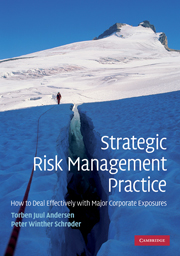Book contents
- Frontmatter
- Contents
- List of abbreviations
- List of figures
- List of tables
- List of boxes
- Preface
- 1 The strategic nature of corporate risk management
- 2 Economic exposures in corporate risk management
- 3 Managing market-related business exposures
- 4 Extending the risk management perspective
- 5 Integrative risk management perspectives
- 6 Current risk management practice and the rise of ERM
- 7 Strategic risk analyses
- 8 Strategic risk management – amendments to the ERM framework
- 9 Strategic risk management
- 10 Postscriptum
- Appendices
- Appendix 1 A strategic responsiveness model
- Appendix 2 Determining the premium on a call option
- Appendix 3 Determining the value of a real option
- Index
- References
6 - Current risk management practice and the rise of ERM
Published online by Cambridge University Press: 05 June 2012
- Frontmatter
- Contents
- List of abbreviations
- List of figures
- List of tables
- List of boxes
- Preface
- 1 The strategic nature of corporate risk management
- 2 Economic exposures in corporate risk management
- 3 Managing market-related business exposures
- 4 Extending the risk management perspective
- 5 Integrative risk management perspectives
- 6 Current risk management practice and the rise of ERM
- 7 Strategic risk analyses
- 8 Strategic risk management – amendments to the ERM framework
- 9 Strategic risk management
- 10 Postscriptum
- Appendices
- Appendix 1 A strategic responsiveness model
- Appendix 2 Determining the premium on a call option
- Appendix 3 Determining the value of a real option
- Index
- References
Summary
This chapter takes a closer look at some of the main drivers behind the demand for a new risk paradigm and outlines the risk management practices evolving from this development. The key components of enterprise risk management (ERM), as a proponent for the new risk paradigm, are described and compared with more traditional approaches to risk management. In this light we discuss the extent to which the new integrative risk paradigm enables corporations to manage their exposures in increasingly dynamic business environments, where organizations are faced with high levels of uncertainty and a decreasing ability to foresee events. The discussion identifies potentially crucial shortcomings associated with the current enterprise-wide risk management approaches, which suggest that some amendments to the generic ERM framework are required to ensure that risk events are identified in time and handled in ways that allow the company to gain foresight and become more responsive.
Drivers of the new risk paradigm
Risk management has long been considered a standard management activity, although the risk focus generally has been limited to those exposures that can be observed, measured and financed through insurance and other financial hedging products, including derivative instruments, or that can be contained through implementation of internal control systems. The main aim in conventional risk management has been to protect the company against the adverse economic effects of various risk events.
Information
- Type
- Chapter
- Information
- Strategic Risk Management PracticeHow to Deal Effectively with Major Corporate Exposures, pp. 120 - 145Publisher: Cambridge University PressPrint publication year: 2010
